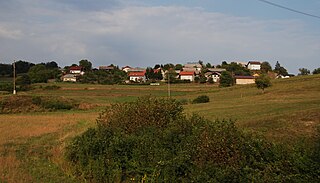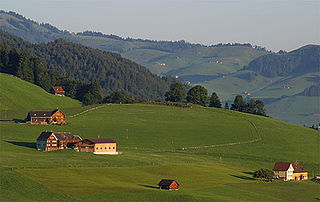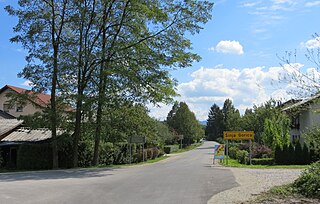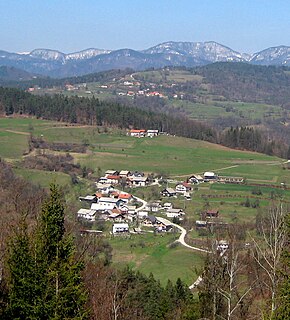
Goveji Dol is a small settlement east of Krmelj in the Municipality of Sevnica in central Slovenia. The area is part of the historical region of Lower Carniola. The municipality is now included in the Lower Sava Statistical Region. In 2006, Brezje, until then a hamlet of Goveji Dol, became an autonomous settlement. In 2008, a part of Goveji Dol and a part of Gabrje merged into a new settlement named Križišče.

Hinje is a small settlement southwest of Šentjanž in the Municipality of Sevnica in central Slovenia. The municipality is now included in the Lower Sava Statistical Region. The area was traditionally part of the historical region of Lower Carniola. The settlement, which was originally part of Koludrje, was established in January 1998 with a decree of the Municipality of Sevnica from 23 December 1997.

Kal pri Krmelju is a small settlement in the Municipality of Sevnica in central Slovenia. The area is part of the historical region of Lower Carniola. The municipality is now included in the Lower Sava Statistical Region.

Kamenica is a small village northeast of Krmelj in the Municipality of Sevnica in central Slovenia. The area is part of the historical region of Lower Carniola. The municipality is now included in the Lower Sava Statistical Region. Until 2001, the settlement included the area of now autonomous settlement of Kamenško.

Kladje pri Krmelju is a settlement in the hills northwest of Krmelj in the historical region of Lower Carniola in central Slovenia. It belongs to the Municipality of Sevnica. The municipality is included in the Lower Sava Statistical Region.

Koludrje is a small settlement south of Šentjanž in the Municipality of Sevnica in central Slovenia. The area is part of the historical region of Lower Carniola and is now included in the Lower Sava Statistical Region.

Metni Vrh is a dispersed settlement in the hills north of Sevnica in east-central Slovenia. The area is part of the historical region of Lower Styria. The Municipality of Sevnica is now included in the Lower Sava Statistical Region.

Orehovo is a settlement in the Municipality of Sevnica in central Slovenia. It lies on the left bank of the Sava River northwest of Sevnica. The area was traditionally part of Lower Styria. The municipality is now included in the Lower Sava Statistical Region.

Osredek pri Hubajnici is a small settlement southwest of Studenec in the Municipality of Sevnica in central Slovenia. The area is part of the historical region of Lower Carniola. The municipality is now included in the Lower Sava Statistical Region.

Poklek nad Blanco is a settlement in the hills north of Blanca in the Municipality of Sevnica in central Slovenia. The area is part of the historical region of Styria. The municipality is now included in the Lower Sava Statistical Region.

Polje pri Tržišču is a settlement in the Municipality of Sevnica in east-central Slovenia. It lies south of Krmelj in the traditional region of Lower Carniola. The municipality is now included in the Lower Sava Statistical Region.

Radna is a settlement in the Municipality of Sevnica in east-central Slovenia. It lies at the confluence of the Mirna River and the Sava River in the historical region of Lower Carniola. The municipality is now included in the Lower Sava Statistical Region.

Rovišče pri Studencu is a nucleated settlement in the Municipality of Sevnica in central Slovenia. The area is part of the historical region of Lower Carniola. The municipality is now included in the Lower Sava Statistical Region.

Vrhek is a settlement in the Municipality of Sevnica in east central Slovenia. It lies in the hills above the left bank of the Mirna River southeast of Krmelj. The area is part of the historical region of Lower Carniola. The municipality is now included in the Lower Sava Statistical Region.

Vranje is a settlement in the Municipality of Sevnica in central Slovenia. It lies in the hills northeast of Sevnica in the historical region of Styria. The municipality is now included in the Lower Sava Statistical Region.

Telče is a settlement east of Tržišče in the Municipality of Sevnica in east-central Slovenia. The area is part of the historical region of Lower Carniola. The municipality is now included in the Lower Sava Statistical Region.

Brezje is a small village in the Municipality of Sevnica in southeastern Slovenia. It lies on a small rise east of Krmelj and the village of Hinjce and west of the Mirna River. Until 2006, the area was part of the settlement of Goveji Dol. The village is part of the traditional region of Lower Carniola and is included in the Lower Sava Statistical Region. One of the two roads from Krmelj to the main road linking Mokronog and Sevnica runs through the settlement, in the valley south of the village core. A cattle trough stands on its right side at the crossroad leading from it into the village. It was built in the 1940s.

The Municipality of Škocjan, established in October 1994, is a municipality in the traditional region of Lower Carniola in southeastern Slovenia. The seat of the municipality is Škocjan. The Municipality of Škocjan is now included in the Southeast Slovenia Statistical Region. The majority of the municipality is part of the Novo Mesto Administrative Unit, except for the northeastern part, which belongs to the Sevnica Administrative Unit.

Križišče is a small village in the Municipality of Sevnica in southeastern Slovenia. It lies in the valley of Kamenica Creek, northwest of the road linking Sevnica and Mokronog and east of the road linking Krmelj and Šentjanž. The village became an autonomous settlement in 2008, and was formed from parts of the settlements of Gabrje and Goveji Dol. It is part of the traditional region of Lower Carniola and is included in the Lower Sava Statistical Region. One of the two roads from Krmelj to the main road linking Mokronog and Sevnica runs through the settlement. The rail line from Sevnica to Trebnje runs past the southeastern border of the settlement.

Kamenško is a small village in the Municipality of Sevnica in southeastern Slovenia. It lies on a small rise northeast of Krmelj, east of the road connecting Krmelj and Šentjanž, above and to the north of the villages of Brezje and Kamenica. Until 2001, the area was part of the settlement of Kamenica. The village is part of the traditional region of Lower Carniola and is included in the Lower Sava Statistical Region.














